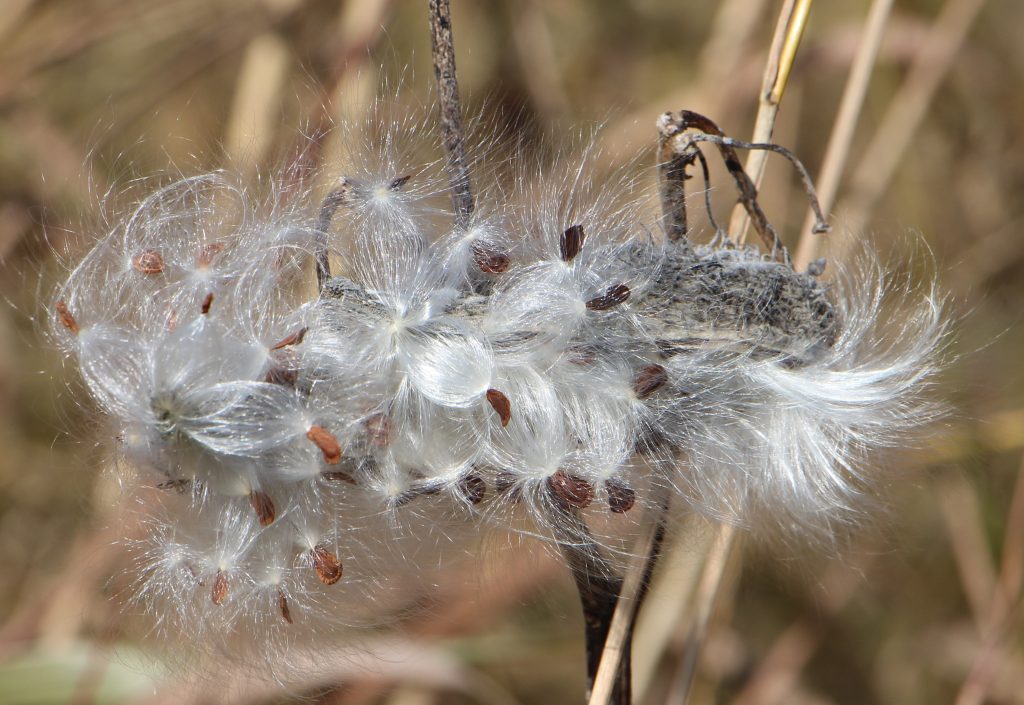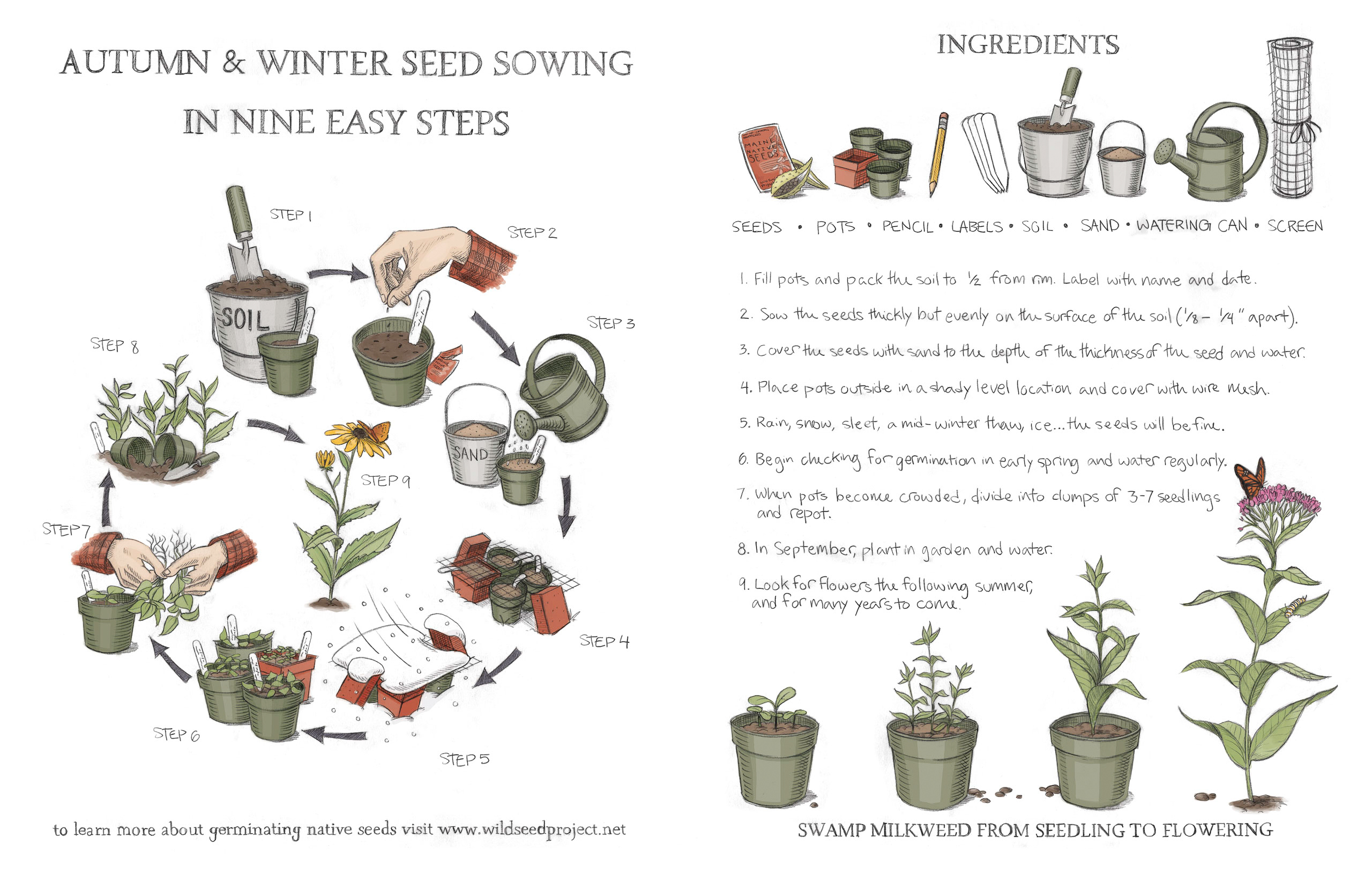Growing your own plants from seed can be an enjoyable and rewarding experience. Although INPS appreciates and strongly supports our native plant growers (see our Buy Natives Directory), we recognize that sometimes you have large spaces to fill. Growing from seed can provide more plants for your property at a much lower cost if you are willing to put in a little time, effort, and patience.
The process can be quite easy, especially with those plants proven to be horticulturally adaptable, such as these Landscape-Worthy Indiana Natives. But there are differences in the method, especially compared to the commonly grown annual vegetables and flowers.
A key difference is that only a few of our native species germinate immediately. Most require a period of cold temperature before they will sprout. For these you will need to follow the technique of “cold stratification” and expose the seeds to cold, moist conditions over time, simulating what the seeds would experience during our typical Indiana winters.
For many, the foremost benefit of growing your own is the joy of developing an intimate relationship with the plant, being able to see the plant at every stage of its development—from seed to seedling, from developing plant to flower.
A word of caution: In our age of extreme biodiversity loss, if you are collecting from the wild, please strictly follow the guidelines below in the Collecting Your Own section, and especially follow the 5% rule.
We hope this piques your interest in growing some of your own natives from seed. Scroll on, and we’ll cover what you need to know to be successful.
We thank Bill Daniels, Vice President of INPS South Central Chapter and Purdue Extension Master Gardener in Brown County, for writing this guide and gathering excellent supporting resources.
Where to Get Seeds
Collect your own.
You may be able to obtain seed from plants wild grown in your area. This is the ecologically sound approach for growing genetically diverse and regionally appropriate species, but you need to follow the rules and collect them ethically.
Native seed companies.
You can purchase seeds from a reputable business, which tracks the seed’s provenance (where the seed came from). We list a few businesses that members have used successfully below.
Seed swaps or exchanges.
Other ways to acquire seeds are our seed swap at the INPS Annual Conference, collecting from your own or your neighbor’s garden, and reaching out to various Indiana native plant groups or the INPS Facebook Group to set up personal exchanges.
Collecting Your Own
Before you get started.
Confirm that your harvesting the seed of a particular species will not harm the long-term viability of a plant population in its native habitat. It is very important that we protect and cherish our native plant species, and not overharvest from them or bring invasive species to those locations. In our zeal to grow native plants from seed, we must not damage the population and other wildlife that depend on them.
Identify the species.
It is critical that you properly identify the plant species before collecting seeds. The best time to identify most plants is while they are in bloom. The many print and online resources (including our Photo Index) and highly accurate digital apps can help you in this task.
Be sure the target plant is not listed as rare, endangered, or threatened.
The Biota of North America Program (BONAP) is a good place to see if a plant is rare in your county. For Indiana, the official list is found in the DNR web document, Endangered, Threatened, and Extirpated Plants of Indiana.
Not your land?
If the plant is not on your land, make sure you have permission before collecting any native seed. Also, it is NOT PERMITTED to collect in national or state parks or in conservation lands. If collecting wild seed along roadways, remember that all property has an owner, even roadsides and places we think are vacant, and it is our responsibility to always make sure we know who the owners are and always get permission.
Be vigilant and avoid “hitchhikers.”
Remember to brush off the soles of your shoes before entering a harvesting location to avoid tracking in unwanted seeds. If driving in, consider hosing down your vehicle and tires if you have previously driven off-road in other natural areas.
Collect at the right time.
This is crucial to ensure successful germination. Know the time of year that the seed should be ready, what the seed looks like when mature, and whether the seed pod or capsule dehisces (opens and expels), etc.
Know how to clean, prepare, and store.
Not all seeds are treated the same way after collection. Some require cleaning before storing, some need to be dried, and others may need to be kept moist.
Observe the 5% rule.
All native plant colonies are important ecologically. Even if wild collecting on your own property, we encourage you to collect no more than 5% of wild (as opposed to garden collected) seeds from an individual plant and 5% of the whole population.
If collecting in a garden or prairie planting, the 5% rule may not be as critical, but even in this situation, consider the importance of letting some of the seed fall. This is especially important in prairie plantings, for they depend not only on the living plants but also on the “seed rain” that ripens and falls to the ground each year. Over-harvesting may disrupt the seed rain and over time impact the overall vitality of a natural space.
Native Seed Companies
When purchasing from a seed company, take the extra step of asking the provenance of the seed you are considering. The goal is to acquire seeds that were harvested closest to your location and ecoregion.
Reputable seed companies have information on file for every seed lot that they carry and may have a different number of lots and ecotypes for each species, depending on the year’s harvest. Typically, this information is available only on request. For instance, Prairie Moon Nursery handles this through a quote system, and can provide you with the closest available ecotype to your specified location before you purchase.
Roundstone Native Seed Company
Spence Restoration Nursery (wholesale)
Stantec Native Plant Nursery (wholesale)
Sowing Your Native Seed
 One of the exciting things about growing your own native plants from seed is that you do not need a lot of expensive equipment, such as a greenhouse or indoor lighting system. All you really need are a few pots (or a bunch if you are going big!), some organic potting soil, coarse sand, and hardware cloth. Other methods may add plastic milk/water jugs or self-seal baggies, but that is pretty well it.
One of the exciting things about growing your own native plants from seed is that you do not need a lot of expensive equipment, such as a greenhouse or indoor lighting system. All you really need are a few pots (or a bunch if you are going big!), some organic potting soil, coarse sand, and hardware cloth. Other methods may add plastic milk/water jugs or self-seal baggies, but that is pretty well it.
Each type of seed has its own germination timetable and pretreatment needs.
Some begin germination immediately upon planting, but most need a cold, moist period (winter, or like it) to properly germinate. Others require a warm period before the cold, moist period.
One of the best resources for understanding the germination needs of your seeds is Prairie Moon Nursery’s website. When you select a specific species, it gives you important information, such as favored growing conditions and native range, and provides you with the germination needs of each species using a germination code system.
Wild Seed Project and other organizations have similar germination code systems. Here is an excellent resource from Prairie Moon Nursery for understanding germination requirements. Finally, another great resource for understanding germination requirements are William Cullina’s books, Growing and Propagating Wildflowers of the United States and Canada and Native Trees, Shrubs, and Vines: A Guide to Using, Growing, and Propagating North American Woody Plants.
Stratification Methods
The most common germination pattern among temperate wildflowers is the need to have a cold, moist stratification period. There are three basic methods. All are acceptable.
Nature’s way.
The first, described in detail by the Wild Seed Project team, simulates closely how it is done in nature. The seeds are planted in pots, trays, flats, or outdoor boxes in late fall or early to mid-winter, exposing them to the natural environmental processes. This instructional video, Wild Seed Project: Planting Native Plants from Wild Seed by Ginger Laurits, is a must see if thinking about using this method. Also, see Wild Seed Project’s guidance How to Grow Natives from Seed.
Winter sowing.
Another outdoor method, winter sowing incorporates the use of containers, especially water or milk jugs, that act like mini greenhouses. In this highly informative webinar, Winter Sowing: An Innovative Method of Sowing Seeds Outdoors, Dolly Foster covers the ABCs of this sowing process. In addition, Dolly has an instructive pamphlet worth reviewing: Spring and Summer Sowing Method. Adherents of this method also have an active Facebook group, Winter Sowers.
Indoor stratification.
This method is especially good if you receive your seeds late in the winter. You sow your seeds directly in pots, trays, or flats, and place them in a plastic bag in the refrigerator (not freezer) for the time recommended, according to the seed’s germination code. Or, mix the seed with damp sand or vermiculite, or place it in a moistened coffee filter in a self-seal baggy and put it in the refrigerator. Natalie Marinova’s presentation Growing Native Plants from Seed covers the latter method in detail.


